Click link to return to the Oase Filtral All-in-One Pump product page.
Oase Filtral All-in-One Pump Information
The Oase Filtral UVC is an all in one pond filtration solution, this means that contained within the unit there is a UVC, filter media and also a pond pump. These units take away the need to have an external filter outside the pond which can in some cases be unsightly and also impractical to the pond owner. It gives an option of complete pond filtration, low running costs and exceptional value to all small pond owners.
The basic idea behind the Oase Filtral is that it will sit on the bottom of your pond (being a flat design it suits itself very well to really shallow ponds) it then draws water that contains sludge, floating particles and algae through the cage to the filter media. Here there are two foam filter layers (one which is blue and coarse and a black foam which is much finer) these foams provide your pond with mechanical filtration.
Mechanical filtration is for the removal of all pond solids, it helps to keep the pond clear and healthy, also these solids would block the biological media if they were not trapped by the foams and this would starve the friendly bacteria of oxygen and give it no room to grow. To help this process try and keep on top of regular maintenance of your filter so that your pond remains crystal clear all year round. Cleaning the foams regularly will make sure it doesn't take a massive amount of time and it shouldn't be as messy! All you need to do to clean the foams is remove the foam layers from the filter and rinse them until clean in a bucket of pond water.
The next stage of filtration within your Oase Filtral unit is the biological media, there will be first a bag of special filter granulate, this not only acts as a buoyancy aid but it also acts as a perfect place for friendly nitrifying bacteria to cultivate. There are also bio-surface elements in the Oase Filtral and these offer a huge surface area to promote the growth of millions of friendly bacteria.
Once the water has passed through the biological media, it passes through a UVC, where a UV bulb emits light and damages the outside layer of tiny algae cells. This process is called flocculation which clumps the algae particles together so that they're larger in size and can be filtered out of the water to stop it going a pea green colour. (A pea green soup is not dangerous to fish, this is a common misconception as koi in Japan are actually grown in green algae ponds. However as a pond owner it's quite nice to be able to see your fish and this is why we suggest a UVC!)
The water is then sent either up to a waterfall or straight back into the pond via hosing, you can alternatively buy an add on for a fountain attachment which will recycle the water as shown in the pictures below.

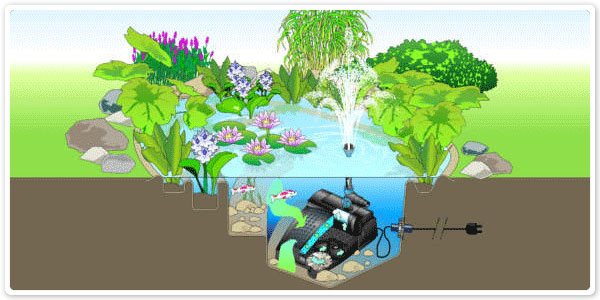
Why should I promote friendly bacteria?
Nitrifying bacteria cultivate in warmer spring, summer and autumn temperatures when your fish are most active and are feeding a lot, this in turn produces a lot of waste products which are toxic to fish. The most dangerous waste product produced is called ammonia, this is excreted from the gills of a fish but can also be present in faeces, urea, decaying plant matter, uneaten fish food, or an excess build up of pond sludge. These warmer temperatures are when we start feeding our fish, this means free ammonia will be present in our pond water in dangerously high numbers. To help give our filter a little boost to start dealing with all this free ammonia we can add a filter start treatment, this will help to promote the growth of nitrifying bacteria in our pond. The first of these bacteria we need to promote the growth of is called nitrosomonas, this friendly bacteria converts poisonous ammonia into nitrite, however nitrite is still poisonous to your fish so we need nitrobacter to convert nitrite into nitrate which is essentially a plant food.
As previously mentioned ammonia is poisonous, but what does it actually do to cause harm to your fish? Well ammonia attacks the gills of your fish which in the long term can cause permanent damage, the more immediate concern however is that it stops the fish being able to supply oxygen to its blood, so it basically suffocates the fish causing it a huge amount of distress. If you are experiencing an ammonia spike within your pond, you will most likely see fish crowding around the return of a waterfall or fountain gasping for air as they struggled to take in oxygen.
If you find ammonia through water testing (testing kits can be bought from us by clicking here, they are an essential addition to any pond owners cupboard, as they will help detect early problems), you will need to get to the bottom of the problem straight away. The three main causes of an ammonia spike will be the rapid introduction of fish to your pond (this mean adding too many new fish which doesn't allow the bacteria within your filter to get up to speed with the increase of ammonia), feeding excessive food (this is due to not feeding over winter and then restarting, you should always try do this very gradually), or lots of leaves falling into a pond in autumn (this is a very common problem, try buying a pond cover to avoid this scenario).
To reduce ammonia you must:
- Lower stocking densities: Small quantities of fish produce less waste, and you have to leave scope for your fish to grow. (We need to remember that a small number of large fish produce less waste than a large number of small fish.)
- Reduce Feeding: Over fed fish will excrete more ammonia, their faeces will also contain partially undigested food which will then rot producing more ammonia.
- Improve general pond husbandry: The best way of avoiding ammonia problems is to never let one of the causes happen, so never over stock, follow guidelines from manufacturers, remove uneaten food etc.
- Improve Biological Filtration: Make sure you maintain your filter correctly, you can add more media or an air stone to the filter to improve the oxygen intake to the filter media.
- Dilution By Water Change: In emergencies the level of total ammonia may be too extreme and you will need to do a water change to remove ammonia, make sure the water is dechlorinated.
Technical Data for the Oase Filtral
| Technical Data | Filtral UVC 2500* | Filtral UVC 3000 | Filtral UVC 5000* | Filtral UVC 6000 | Filtral UVC 9000 |
|---|---|---|---|---|---|
| Dimensions (L x W x H) | 247 x 183 x 160 | 250 x 185 x 160 | 380 x 290 x 160 | 380 x 290 x 160 | 380 x 290 x 160 |
| Power Consumption | 20 Watts | 20 Watts | 35 Watts | 38 Watts | 40 Watts |
| Power Cable Length | 10 Metres | 10 Metres | 10 Metres | 10 Metres | 10 Metres |
| Net Weight | 3.18 Kg | 3.3 Kg | 4.96 Kg | 4.5 Kg | 4.5 Kg |
| Guarantee | 2 Years | 2 Years | 2 Years | 2 Years | 2 Years |
| UVC Power | 7 Watt | 7 Watt | 11 Watt | 9 Watt | 11 Watt |
| Pump Capacity | 1000 Litres Per Hour | 1000 Litres Per Hour | 2500 Litres Per Hour | 2500 Litres Per Hour | 2500 Litres Per Hour |
| Flow Rate | 600 Litres Per Hour | 600 Litres Per Hour | 1100 Litres Per Hour | 1100 Litres Per Hour | 1100 Litres Per Hour |
| Max Head Height | 1.30 Metres | 1.30 Metres | 2.30 Metres | 2.30 Metres | 2.30 Metres |
| Filter Surface Area | 232 Cm2 | 232 Cm2 | 564 Cm2 | 564 Cm2 | 564 Cm2 |
| Number of Blue Foams | 1 | 1 | 1 | 1 | 1 |
| Number of Black Foams | 1 | 1 | 1 | 1 | 1 |
| Bio-Surface Elements | 2 | 2 | 8 | 8 | 8 |
| Special Filter Granulate | 0.20 Grams | 0.20 Grams | 0.40 Grams | 0.40 Grams | 0.40 Grams |
| Connection, pressure side | 1/2", 3/4", 1" | 1/2", 3/4", 1" | 1/2", 3/4", 1" | 1/2", 3/4", 1" | 1/2", 3/4", 1" |
| Suitable For A Max Pond Size | 2500 | 3000 | 5000 | 6000 | 9000 |
| Max Pond Size With Fish | 1300 | 1500 | 2500 | 3000 | 4500 |
*The 2500 and 5000 models have now been discontinued and are no longer available. We have left them in the table for comparison purposes only.
Oase Filtral Maintenance
You will notice that from time to time the flow of your Oase Filtral may get slower, this most likely will indicate that the unit needs to be cleaned. The first thing you will need to do is isolate the power to the unit, once this has been done you will be able to lift your Oase Filtral out of the pond. You will most likely find that the Filtral is covered in some pond sludge and slime, the best thing to do is remove the outer cage by removing both clips (one at the back and one at the front) then just lifting the cage off.
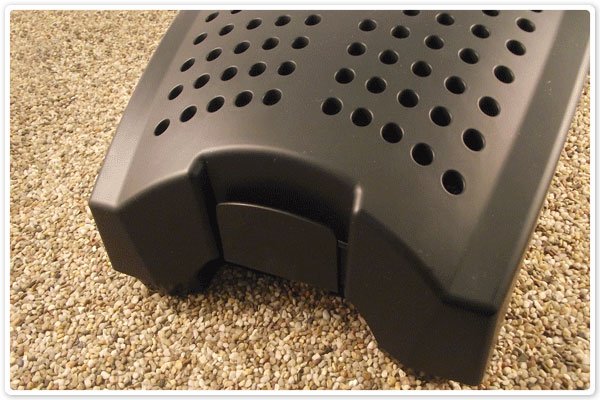
Once the cage has been removed you will be able to give it a good rinse with a hosepipe and then use a cloth to clean all the holes and wipe the inside of the caging clean, this can be then set aside to re-assemble later.

You will see the big coarse blue foam (as above), this should be removed and cleaned as much as possible into a bucket of pond water (cleaning the foam with a hosepipe could kill all the bacteria within your filter). The next job is to clean the black foam as well, this is located underneath the blue foam and takes out the finer particles as mentioned previously, this should be done also with a bucket of pond water.
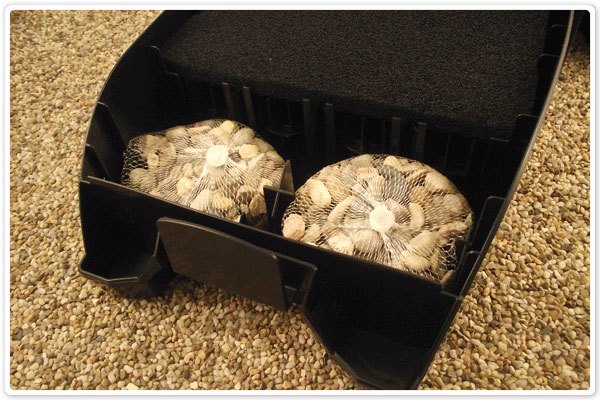
The special filter substrate that also acts as a buoyancy aid will probably get blocked with sludge also, make sure you give these a rinse out also in the pond water to make room for new bacteria to be able to cultivate, then rinse out the compartment where they are situated to get rid of all the sludge.

More often than not you will be able to leave the biomedia chamber, cleaning this thoroughly will result in you washing away beneficial bacteria and this could have a negative effect on your pond. You can see these shown above, if they are very dirty, very gently dip them in the pond water bucket and then replace into the filter.
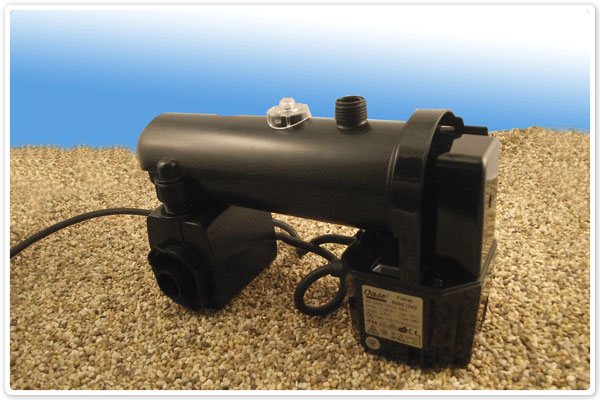
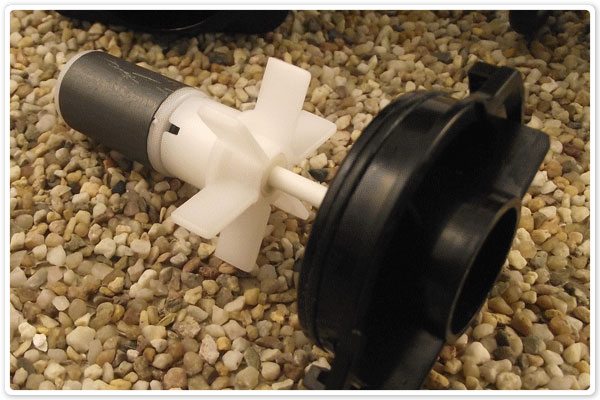
If you find that the flow from your Filtral is still slow after cleaning your foams it may be worth checking the pump to see whether it is blocked. Dismantle the UVC and the pump, this just lifts away from the main body of the Filtral. You can then clean all the outside of the pump and remove the impeller if needed, to clean inside the body of the pump, to do this take the impeller cover off by turning it clockwise and then you can pull out the impeller as shown above.


If you notice that the pond is going green or it's the start of the season you may well need to change your UV bulb, and this with the Oase Filtral is really easy. If you notice on the first picture above and also if you're looking at your Filtral there is a clip that needs to be pushed in, the arrow on the unit is then showing you which way you need to then turn the unit to unlock it. Once unlocked you will be able to see the quartz sleeve and the UV bulb inside the quartz, it's more than likely that the quartz will have become slightly tainted with algae, so you can clean this with a damp cloth so that the UV light is able to pass through the quartz properly.
In the second picture above you will see the screw which releases the quartz sleeve and allows you to change the bulb, when changing the bulb remember not to touch the new bulb with your hands and to use a dry cloth (touching the UV bulb can put oily finger prints on the bulb, which will heat up and cause the bulb to break).

